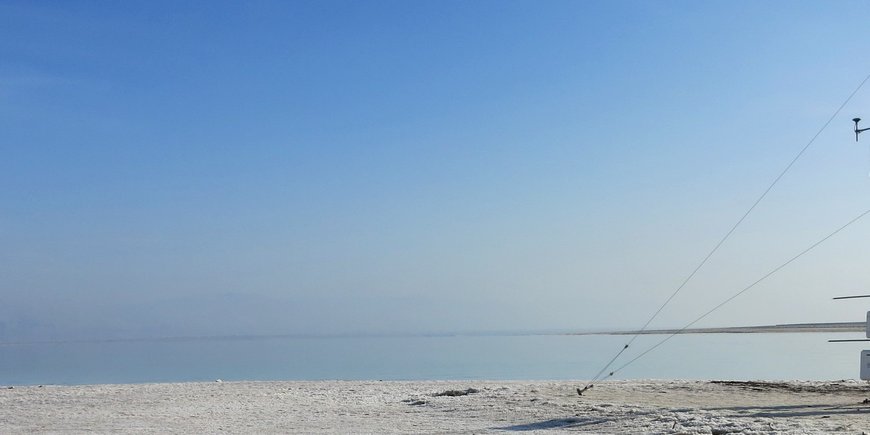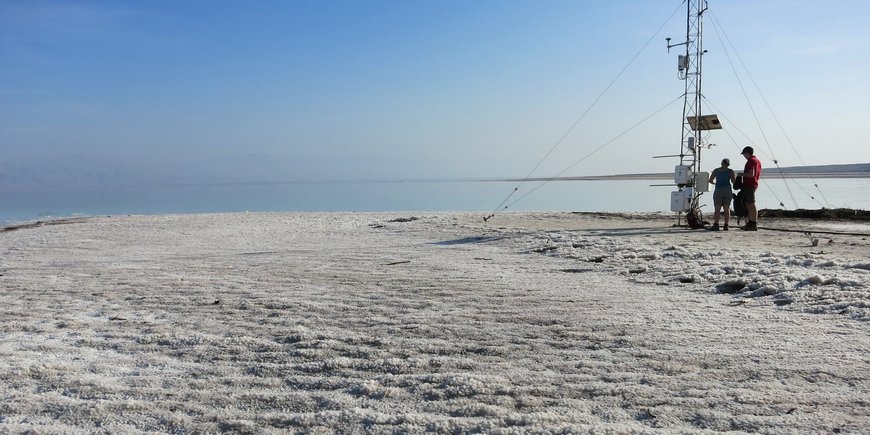The Dead Sea is shrinking. There are many reasons for this: climate change is a contributing factor, as is human overuse of water as a resource. The sinking water level has a number of dangerous consequences. For example, fresh groundwater flowing downstream causes salts to dissolve in the soil, resulting in sinkholes. But it also leads to large-scale subsidence of the surrounding land surface. Researchers from an interdisciplinary team of several sections from the GFZ German Research Centre for Geosciences, together with colleagues from Hannover, Kiel and Padua, have now for the first time demonstrated a direct link between the decrease in the water table, evaporation and land subsidence. They report on this in the journal Scientific Reports.
The team used a wide range of instruments; from measurement methods based on the Global Navigation Satellite System (GNSS) to radar satellites and on-site gauge and climate stations. The researchers showed that the solid earth moves up and down synchronously with fluctuations in the water surface and groundwater level with a time lag of about eight weeks. However, the trend is clearly in one direction: downward.
The water level of the Dead Sea sinks about one meter per year, and the land sinks about 15 centimeters per year. Inflows from rainfall in the surrounding mountains and the Jordan River cause short-term rises in the lake level. However, water withdrawals from the tributaries for agriculture, pumping of saline water to extract potassium, and evaporation in the high heat turn the balance permanently negative.
The coupling of land subsidence to the sinking water table has long been clear. But the fact that the movement of the land surface is so directly related to hydro-meteorological fluctuations is new. The researchers determined this connection within three years. For agriculture, tourism and infrastructure in the region, land subsidence and water loss are very threatening. The measurements show for the first time how closely land, water and atmosphere are linked here.
Original study: Sibylle Vey, D. Al-Halbouni, M. Haghshenas Haghighi, F. Alshawaf, J. Vüllers, A. Güntner, G. Dick, M. Ramatschi, P. Teatini, J. Wickert & M. Weber: Delayed subsidence of the Dead Sea shore due to hydro-meteorological changes; in: Scientific Reports.
Link: https://www.nature.com/articles/s41598-021-91949-y
Scientific Contact:
Dr. Sibylle Vey
Visiting researcher in the GFZ section Hydrology
Tel: +49 331 288-28786
E-mail: sibylle.vey@gfz-potsdam.de
Prof. Jens Wickert
Deputy Head of the Section Geodetic Space Methods and Director of the Topic "The Atmosphere in Global Change" in the Helmholtz Research Programme "Changing Earth - Sustaining our Future".
Tel.: 0331 288-1758
E-mail: jens.wickert@gfz-potsdam.de
Media Contact:
Dipl.-Geogr. Josef Zens
Head Public Relations
Telegrafenberg
14473 Potsdam
Tel.: +49 331 288-1040
E-Mail: josef.zens@gfz-potsdam.de









![[Translate to English:] Torsten Sachs in front of a climate station on a field](/fileadmin/_processed_/3/9/csm__TorstenSachs_bearbeitet_GS_4a1365ef84.jpeg)

![[Translate to English:] left image flood at the Ahrtal: image from above, several houses are flooded; left image:: Heidi Kreibich;](/fileadmin/_processed_/4/4/csm_Bild2_9af0130e9f.png)



![[Translate to English:] Start der Vega Rakete](/fileadmin/_processed_/6/4/csm_20231201-kachel_Vega-VV23-launch_ESA-CNES-Arianespace_706716b68c.jpeg)









![[Translate to English:] Poster exhibition at the Brandenburg Hydrogen Day at the GFZ, some participants in the foreground](/fileadmin/_processed_/6/5/csm_Erster_Brandenburgischer_Wasserstofftag_GFZ_402fcec95e.jpeg)
![[Translate to English:] Group picture of the participants](/fileadmin/_processed_/9/4/csm_20231108_CAWa-Workshop-Tashkent_Gruppenbild_99ea779d8a.jpeg)

![[Translate to English:] [Translate to English:] Hörsaal](/fileadmin/_processed_/e/6/csm_H%C3%B6rsal_e21ac645fb.jpeg)


![[Translate to English:] The Delegations in the Historic Library on the Telegrafenberg. In the back there are from left to right, the Dutch Ambassador for Germany, Ronald van Roeden, the Dutch Minister for Education, Culture and Science, Robbert Dijkgraaf and the scientific director of the GFZ, Susanne Buiter.](/fileadmin/_processed_/d/b/csm_Kachel-2_9eba4b4212.jpeg)

